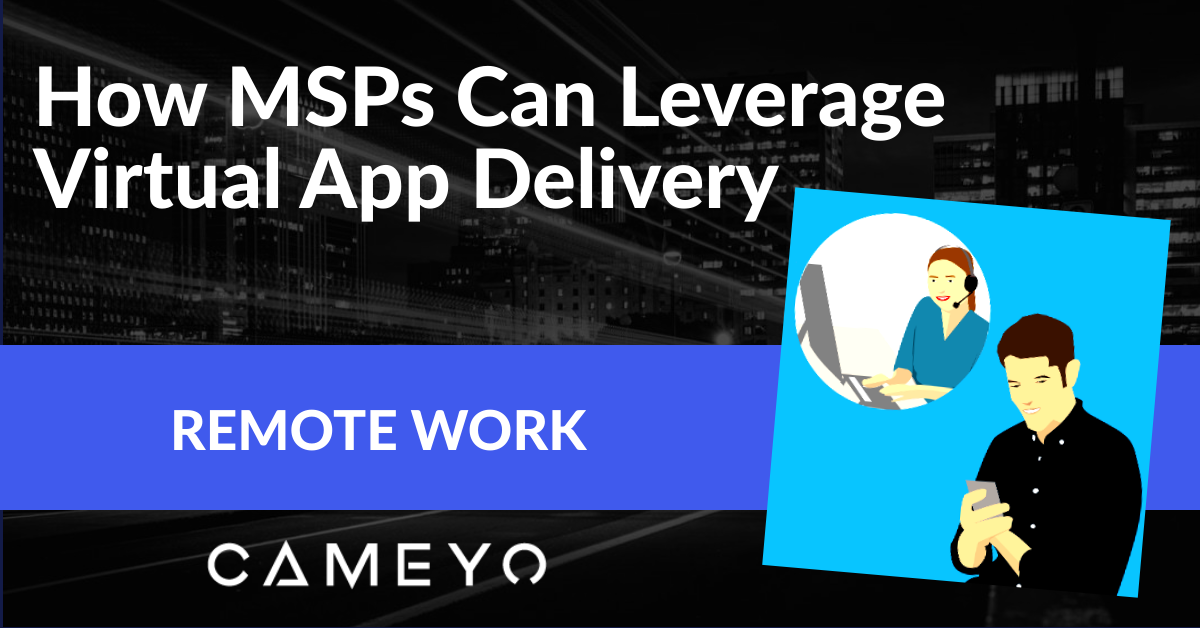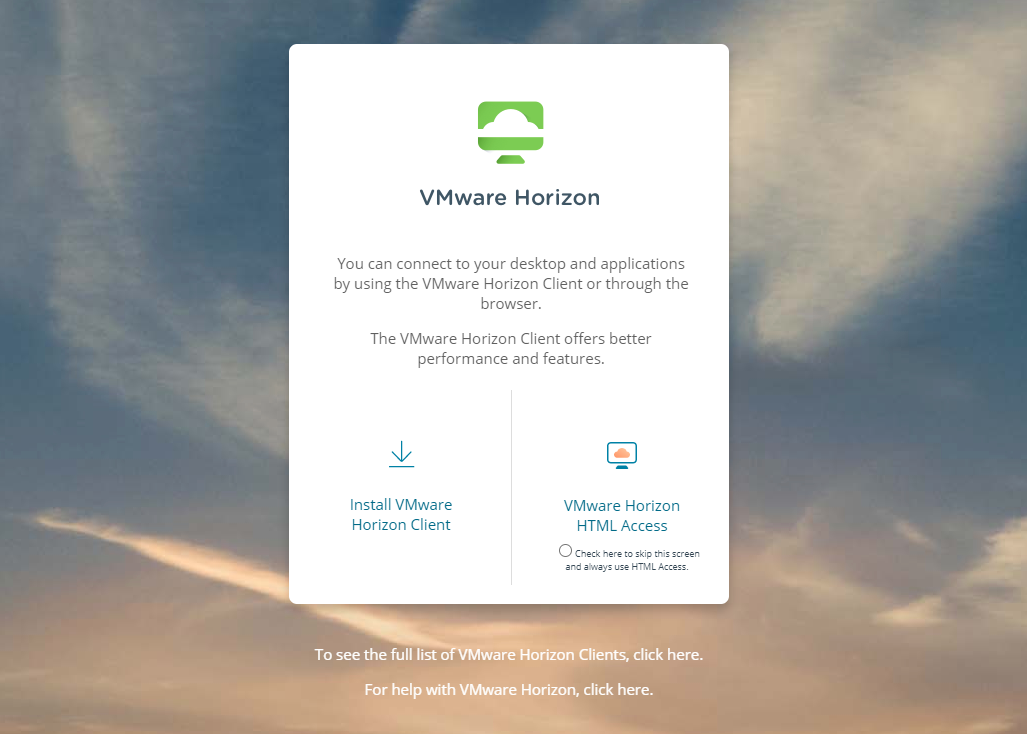At this point in the ongoing pandemic, almost every organization has had to adopt and rely on some level of new technology solutions just to ensure they can continue to carry out business-critical activities with a highly distributed workforce. 
Many of these organizations rely on managed service providers (MSPs) to deliver and manage those technology solutions for their business. And the pandemic has made the role of the MSP more strategic than ever.
MSPs have had to step up to the challenge of enabling software delivery at a larger scale, with great flexibility, while also providing more options to their customers. How is virtual app delivery helping MSPs to meet these new challenges? Let’s take a deeper look, and then zoom in to see how Cameyo’s Digital Workspace platform provides MSPs with a particularly useful solution to empower their customers’ businesses in an ever-changing world.
Traditional Options for MSPs and Customers
Traditionally, MSPs tasked with enabling customers to deliver applications to end-users had conventional virtual desktop infrastructure (VDI), Desktop-as-a-Service (DaaS), or Remote Desktop Services (RDS) technologies at their disposal. While these technologies certainly enable customers to deliver remote workers’ applications, these are often not the most efficient, flexible, or cost-effective approach.
VDI is expensive to implement, requiring dedicated virtualization environments with flash storage requirements for acceptable performance. VDI is also a very complex technology to deliver effectively. MSPs often find supporting VDI infrastructure time-consuming, costly, and generally overkill for customers who simply want to access Windows applications for end-users. Desktop-as-a-Service (DaaS) solutions have brought new options to the table. However, DaaS again may not be the best solution for customers who want to deliver access to applications for end-users in a flexible and cost-effective way.

Remote Desktop Services (RDS) is a longstanding traditional technology that has been relied upon in the enterprise for years now. Many MSPs have turned to RDS as a solution to enable customers to access their business applications remotely. While RDS works and provides a familiar solution that MSPs are often comfortable leveraging, full-blown RDS infrastructure deployments can be challenging to manage for multiple customers. Addressing customer’s security concerns and staying on top of RDP security challenges can also be extremely difficult.
Now to be fair – if your organization has a certain percentage of power users who truly need a full virtual desktop environment, then it makes sense to use VDI or DaaS for those users. But for the rest of their users who simply need secure access to all of their business-critical Windows applications on any device – there are other options.
Modern Virtual Application Delivery
There is a common theme among most customers looking to empower their remote workforce. For many, remote workers need access to applications and not necessarily desktops. It is an important distinction to make as MSPs can leverage more efficient and effective technologies to empower customers to meet their business needs, outside of the traditional technologies used for years.
Virtual application delivery enables the delivery of applications to the end-user without the need for a full virtual desktop. MSPs have a strategic opportunity to identify what percentage of their customers’ users actually need full virtual desktops, and what percentage just needs virtual access to all of their critical Windows apps. For those who just need their apps, it is highly inefficient to deliver all the necessary infrastructure to provide a full desktop session if the end-user does not need this.
Virtual application delivery allows the delivery of what customers need in a highly efficient and cost-effective way. MSPs tasked with providing access to applications instead of desktops can leverage much more efficient infrastructure and solutions for this purpose. It also allows MSPs to offer a much simpler, more flexible solution.
Cameyo Empowers MSPs to Simply & Securely Deliver Virtual Applications
Today, MSPs face various challenges to meet customer demands and compete in a landscape where it is becoming increasingly difficult to grow revenue and simplify application delivery. These challenges can be summarized by the following:
- Delivering value-added services in a cost-effective manner
- Providing simple solutions – both from the customer experience perspective and the long-term management perspective
- Empowering customers with flexible solutions that enable them to scale up/down based on business needs
By shifting to virtual application delivery in a world where customers are focused on remote work and access to applications, MSPs can effectively generate revenue growth and simplify the delivery of applications for customers.
Cameyo is a cloud-native virtual application delivery platform that brings Windows applications to any device through the web browser. It does this with intrinsic simplicity and security built-in. Cameyo for MSPs, released in March 2020, helps build profitable virtual application delivery practices while eliminating the cost and complexity of virtual desktops. Cameyo’s solution is tailored to MSPs’ needs and allows delivering Windows applications to any device.
Since Cameyo delivers applications from any HTML5 browser, there is no client-side software to install. It eliminates the need for MSPs to manage software on potentially hundreds or thousands of end-user devices to consume virtual applications effectively.
Cameyo is also a solution MSPs can deploy in minutes, not hours or days. The intrinsic simplicity of Cameyo for MSPs leads to further increased revenue potential, simplified provisioning, and management. The simple delivery of virtual applications by Cameyo also transitions to the customer. It allows easy co-management if shared with customer IT staff and fewer end-user issues accessing business-critical apps.
Key benefits of Cameyo for MSPs:
- Simplified Management – Easily add new customers and deliver the apps they need to any devices within minutes, all from a single pane of glass in your Cameyo for MSP dashboard.
- Reduced Cost – Eliminate the high cost of VDI licensing and deliver a more secure solution with a significantly lower cost per user.
- Eliminate Complexity – Remove the complexity of managing VDI across multiple customer environments, and deliver seamless software updates that are completely transparent to your customers.
- Enhanced Security – Cameyo’s solution is fully encrypted and adds a security layer by separating applications from the operating system. All customer data is protected and private and never resides on a Cameyo server, plus your customers can lock user settings for PCI and data compliance needs. Cameyo provides Port Shield, Layered Revert, and Session Sync for a Zero Trust approach to remote work security.
- Easy Scalability – MSPs are not required to set up a different VDI environment for each customer. Cameyo for MSPs lets you easily add new customers in your Cameyo dashboard and get them started in minutes, not weeks or months.
Providing Cloud Agility
Using Cameyo for MSPs provides the cloud agility they need to offer virtual application delivery to all of their customers. MSPs can quickly get started with Cameyo with a self-hosted solution or a Bring Your Own Cloud (BYOC) approach. For self-hosted solutions, Cameyo is easily installed on Windows Server 2016 and higher in an MSP data center. After installation, using Cameyo’s admin console, MSPs can quickly add customers and start provisioning customer applications.

Cameyo’s easy admin console allows MSPs to quickly provision customer apps
In addition to the self-hosted solution, MSPs can take advantage of the full features and benefits of Cameyo’s cloud platform by deploying it in their own Microsoft Azure or Google Cloud environments. It allows customers to take full advantage of the “cloud DNA” of Cameyo. Housing Cameyo in the cloud includes the elasticity and usage optimization technologies that help to dramatically reduce cost by dynamically spinning up and down servers based on demand. Also, Cameyo’s Session Sync technology provides data resiliency and file synchronization between sessions, providing a seamless user experience.
MSPs Benefit from Leveraging the Right Tools
To stay competitive and offer customers the right options, MSPs must use various tools and software delivery solutions. Is one solution the “end all be all” that is right for every use case? No. However, virtual application delivery is exceptionally well-suited for end-users who need access to applications and not desktops.
And it’s not an either/or proposition – you can always utilize virtual desktops for the small percentage of power users who need that, and then utilize virtual app delivery to simplify (and reduce the cost of) delivery of business-critical apps to the rest of your customers’ users. For MSPs, having the right tools and leveraging the right solution for each specific customer use case grows revenue potential, improves simplicity, and provides the flexibility that customers need.
Wrapping Up
Today, MSPs are tasked with providing technology solutions for businesses to meet the challenges of a world in the grips of a global pandemic and who need to provide access to business-critical applications. Virtual application delivery platforms like Cameyo allow MSPs to offer extremely efficient and cost-effective solutions to their customers. It eliminates the need to provision full-blown VDI environments when desktop sessions are not needed. It also provides a cloud-native approach to delivering a modern solution that offers elastic scalability and flexibility.
Want to see how simple it is to deliver virtual apps with Cameyo? Start your free trial in minutes here.
